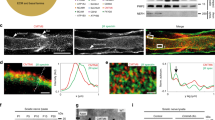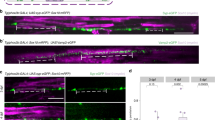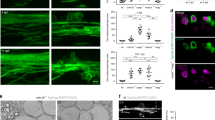Abstract
Evidence for the transfer of molecules as large as proteins from glial or Schwann cells to axons has frequently been reported1–8. This phenomenon is well supported in crayfish3,4,8 and squid5–7 but there is some doubt about its existence in vertebrates9. In invertebrates most of the data support the transfer from glial cells to axons, but little is known about movement of molecules in the opposite direction. However, Grossfeld et al.10 recently reported data on the passage of a fluorescent dye (Lucifer yellow CH, molecular weight (MW) 476) from a crayfish median giant axon to all glial cells of the adaxonal layer. Little is known of the mechanism by which molecules are exchanged between axons and glial cells, but the bidirectionality of the phenomenon in crayfish axons suggests that channels or pores for direct intercellular communication may exist. In most cells, direct communication is provided by gap junctions11 but these structures have never been seen between axons and glial cells of crayfish12–14. Indeed, regions of plasma membrane specialization have been reported13, but they are structurally different from gap junctions. I describe here pore structures, observed between 51 axons and glial cells of six crayfish spinal cords, which may represent the means of communication between these cells.
This is a preview of subscription content, access via your institution
Access options
Subscribe to this journal
Receive 51 print issues and online access
$199.00 per year
only $3.90 per issue
Buy this article
- Purchase on Springer Link
- Instant access to full article PDF
Prices may be subject to local taxes which are calculated during checkout
Similar content being viewed by others
References
Singer, M. & Salpeter, M. J. Morph. 120, 281–316 (1966).
Singer, M. & Green, M. R. J. Morph. 124, 321–344 (1968).
Andersson, E., Edstrom, A. & Jarlstedt, J. Acta physiol. scand. 78, 491–502 (1970).
Bittner, G. Am. Zool. 13, 379–408 (1973).
Lasek, R. J., Gainer, H. & Przybylski, R. J. Proc. natn. Acad. Sci. U.S.A. 71, 1188–1192 (1974).
Lasek, R. J., Gainer, H. & Barker, J. L. J. Cell Biol. 74, 501–523 (1977).
Gainer, H., Tasaki, I. & Lasek, R. J. J. Cell Biol. 74, 524–530 (1977).
Meyer, M. R. & Bittner, G. D. Brain Res. 143, 213–232 (1978).
Gambetti, P., Autilio-Gambetti, L. & Peck, K. Brain Res. 200, 59–68 (1980).
Grossfeld, R. M., Bittner, G. D., Ballinger, M. L. & Viancour, T. A. Soc. Neurosci. Abastr. 6, 385 (1980).
Peracchia, C. Int. Rev. Cytol. 66, 81–146 (1980).
Peracchia, C. J. Cell Biol. 44, 125–133 (1970).
Peracchia, C. J. Cell Biol. 61, 107–122 (1974).
Peracchia, C. & Robertson, J. D. J. Cell Biol. 53, 223–239 (1971).
Van Harreveld, A. Proc. Soc. exp. Biol. Med. 34, 428–432 (1936).
Author information
Authors and Affiliations
Rights and permissions
About this article
Cite this article
Peracchia, C. Direct communication between axons and sheath glial cells in crayfish. Nature 290, 597–598 (1981). https://doi.org/10.1038/290597a0
Received:
Accepted:
Issue Date:
DOI: https://doi.org/10.1038/290597a0
This article is cited by
-
Selective retrograde axonal transport of free glycine in identified neurons ofAplysia
Cellular and Molecular Neurobiology (1984)
-
Motoneurons which may utilize dopamine as their neurotransmitter
Cellular and Molecular Neurobiology (1982)
-
Selective transfer of Lucifer yellow CH from axoplasm to adaxonal glia
Nature (1981)
Comments
By submitting a comment you agree to abide by our Terms and Community Guidelines. If you find something abusive or that does not comply with our terms or guidelines please flag it as inappropriate.



